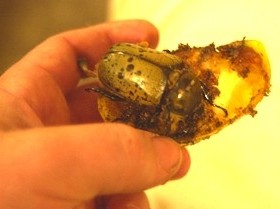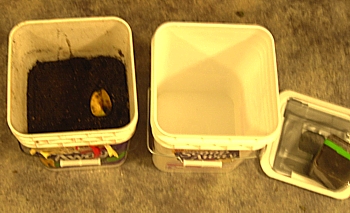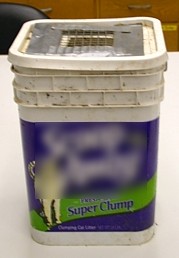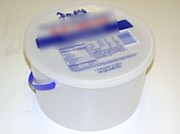|
|
ARTHROPODS:
Insects»
Spiders»
Centipedes»
Millipedes»
Sowbugs»
Harvestmen»
Mites
& Ticks»
Scorpions»
Identification
Tips»
About
the Critter Files»
Links» |
|
|
|
| FEEDING
AND HOUSING ADULT HERCULES BEETLES |
|
Housing:
Adult Hercules beetles spend much of their time burrowing, and should
be kept in containers with 3-4 inches of soil, preferably a sphagnum
moss soil mixture. Because Hercules beetles are primarily nocturnal,
they will spend most of the daylight hours beneath the soil and
will come to the surface at night. Multiple female beetles can be
kept together in a single container with a single male, but males
are aggressive to one another and should be housed separately. |
| |
| Feeding:
Adult male and female Dynastes tityus feed on rotten apples,
orange slices, overripe bananas, and similar fruits. Orange
slices are preferred. Wild-collected adults can live up to three
months on this diet. Adults that are raised from larva can live up
to a year if raised on this diet. An occasional orange can also be
provided. Adults will also feed on “pure” maple syrup
that has been diluted by with 1 part water and offered on a wet sponge.
This type of feeding should be limited because of the expense of the
maple syrup. Also, syrup can allow bacteria to grow quickly in the
sponge. |

Adult female Hercules Beetle feeding on an apple
(B. Wallin 2003) |
| |
| BREEDING
AND REARING |
|
| When a healthy
male and female Hercules beetle are placed together in a container,
mating will typically commence quickly and may last for up to 1 hour.
After a single mating, the adult female beetle is likely to be gravid
(pregnant) and can be separated into an egg-laying chamber. The egg-laying
chamber requires special conditions, outlined below. |
| |

Egg-laying chambers: made from kitty-litter containers
(B. Wallin, 2003) |
|
| Container:
Any large, escape proof plastic or glass container should work as
an egg-laying and rearing chamber, provided that there is enough room
in the container for at least 1 gallon of soil. Large kitty-litter
containers, like the ones pictured above and below right, are a perfect
size, and include lids. Plastic, 5-gallon buckets are also ideal.
Remember to thoroughly clean any of these containers and use them
with caution, especially if they contained cleansers or other chemicals.
Ten-gallon aquaria are also a great choice, and are very inexpensive.
Small, 1-gallon containers can be used to rear single grubs, but the
soil mixture must be changed often. |
| |
| Egg-Laying:
The female should be allowed to live in the egg-laying chamber for
approximately one month, and then removed. She will lay up to 40 eggs,
and these eggs will began to hatch about a month after they have been
deposited. |
| |
| Rearing
Substrate: The rearing substrate for egg-laying and larvae
rearing should contain a mixture of potting soil and rotten wood,
at a 2-to-1 soil to wood ratio. The potting soil should be topsoil,
and can be purchased from a garden-supply store. It must be free of
pesticides, fertilizers, and should include some sand. Many garden-supply
stores sell organic humus that contains no pesticides or artificial
fertilizers. Rotten wood is also essential for the soil mixture: larvae
feed on rotten wood, and female beetles will not lay eggs in soil
that does not contain it. As mentioned above, the egg-laying and rearing
chamber must contain at least 1 gallon of rearing substrate. More
may be necessary in larger containers. |

Large cat-litter container |
| |
| Moisture:
The rearing substrate used for egg-laying and rearing must be kept
moist to the touch. Check the mixture daily, and expect to add
water frequently. If the mixture is allowed to become dry, the
eggs or grubs will not survive. |
| |
| Notes
on Rotten Wood: Wood for egg-laying and rearing chambers
must be rotten hardwood. The wood of pines and other conifers
contain chemicals which are toxic to the beetles. The best wood
will already be in an advanced state of decay, such as exposed logs
found on the forest floor. Hard, dry wood, such as firewood,
will not be eaten by the beetles until it begins to rot, so it is
best to use wood that is already rotten. Most wood collected
outdoors will contain mites, ants, centipedes, and other arthropods,
many of which will attack Hercules beetle eggs or grubs, and it is
important to prepare the wood before it is used to kill these creatures.
Mites are a particular problem because they can "balloon"
like baby spiders. This allows them to infest containers that
have already been decontaminated. The same kitty-litter containers
mentioned above can also be used to soak wood in water before use.
The water level should be sufficient to cover the pieces of
wood, and the wood should soak for 1 week. After soaking, freeze
the wood for 1-2 weeks if possible. Once the wood has been treated
in this manner, it should be broken into small pieces and mixed into
the soil. |
| |
| Additional
Nutrition: The
addition of rotten apples to the soil/wood mixture tends to lead to
larger grubs adult beetles. Dry dog food is another supplement, and
also leads to larger beetles. However, dog food often leads to mite
problems. Chopped, rotten leaves can also be used as a supplement,
and can be used occasionally when wood is unavailable. |
| |

One-gallon ice-cream containers make good pupal chambers. |
Separation
of Grubs: A female will initially lay multiple eggs in a
container, and many of these will hatch into tiny grubs. These grubs
will then feed and grow in the soil/wood mixture. After about 18 months
of feeding, the grubs will enter a "wandering" stage, and
they will need to be placed in individual pupal chambers for pupation.
During this stage, the grubs can be placed in smaller containers with
just enough soil to make pupal chambers. One-gallon containers half
filled with soil are ideal. |
| |
| Emergence:
Adult beetles will emerge from their pupal cases a few weeks after
pupation, but at this time, their exoskeletons are not fully hardened
and the beetles will remain underground for some time. During this
period, the beetles are said to be in a "teneral" state
and are referred to as teneral adults. Because the adults stay underground,
it is not often obvious that they have emerged, and it usually a good
idea to look through the soil every few days for an emerged adult.
It is important to refrigerate the teneral adults (at apx. 40 degrees
F, 4 degrees C) for at least one month (ideally, 2-3 months) following
pupation: this refrigeration period mimics the cool periods that the
beetles experience in the wild. |
| |
| REARING
TIMETABLE |
|
|
| Adult
longevity: Typically 3-6 months. The
rare adult will live up to a year plus.
Egg-laying to egg hatch: 1 month
Egg hatch to pupation: 12-18 months
Pupation to emergence: 2-3 months, depending on
temperature
Emergence
of teneral adults to fully-formed adults: About 1 month
|
| REARING RESOURCES |
|
The rearing
of Hercules beetles and related insects has become a popular hobby
over the last few years, and there are several rearing-resources
available on-line and in print.
LINKS:
The Natural Worlds site
has an extensive online breeding manual for Hercules beetles and
closely related beetles at:
www.naturalworlds.org/scarabaeidae/manual/Scarabaeidae_breeding_1.htm
BOOKS:
For
The Love of Rhinoceros and Stag Beetles: Keeping, Breeding, and
More
By Jonathan T. Lai. An extensive breeding guide, with many pictures.
The
Complete Guide to Rearing Grant's Rhinoceros Beetles& Other
U.S. Rhinoceros Beetles
By Orin McMonigle. For sale on-line at
www.angelfire.com/oh3/elytraandantenna/
|
Original document: 25 May 2004
Last updated: 12 Dec 20046
Photos courtesy W.
Wallin, R. Bessin, and B. Newton, University of Kentucky
The Kentucky Critter
Files are maintained by Blake Newton, Department of Entomology, University
of Kentucky.
Contact: blaken@uky.edu
|
|

